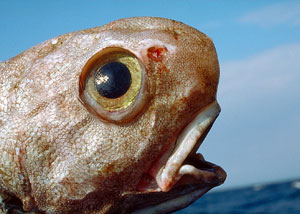Why does the Charlie-Gibbs Fracture Zone need protection?
 The main threats for the Mid-Atlantic Ridge ecosystems known to date have come from three decades of deep-sea fishing for sensitive, slow-growing species and the use of heavy fishing gear, which is operated in contact with the seafloor. This can destroy the thousands of years old coral stands, fragile sponges and other sessile invertebrates in a matter of moments.
The main threats for the Mid-Atlantic Ridge ecosystems known to date have come from three decades of deep-sea fishing for sensitive, slow-growing species and the use of heavy fishing gear, which is operated in contact with the seafloor. This can destroy the thousands of years old coral stands, fragile sponges and other sessile invertebrates in a matter of moments.
Species in the deep and cold ocean waters are especially vulnerable to human impact. Many have similar or longer life spans than humans, they grow and mature very slowly and have only few offspring at irregular intervals. Examples of commercially harvested species are deep-sea sharks (60-70 years), roundnose grenadier (>60 years) or orange roughy (>125 years). Their stocks have been damaged in the past and may need decades to recover, if at all. Future threats are deep-sea mining of minerals and in particular the impacts of climate change.
